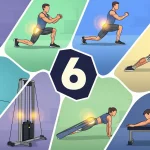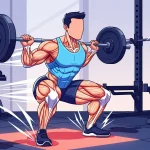Hey, Fit People,
Ever felt this? Your right hand can lift the dumbbell with ease for 10 reps, but your left arm starts shaking at rep 6? Or your right leg nails a split squat with perfect balance, but your left leg sends your whole body doing a shaky dance?
If you said “yes,” you’re not alone. That’s muscle imbalance, and it doesn’t just drop your performance, it also opens the door to injury.
Now imagine this: you keep doing bilateral training (both sides together), your dominant side keeps taking over, and your weaker side falls further behind. The result? Asymmetrical posture, increased injury risk, and plateaued progress.
This is exactly where unilateral training steps in as your secret weapon.
What Is Unilateral Training?
Unilateral training focuses on working one side of the body at a time. Think:
- Single-arm row
- Single-leg deadlift
- Bulgarian split squat
Unlike bilateral movements like squats or bench presses, unilateral moves make you isolate and control each side, no cheating. It’s like having a one-on-one session with your muscles.
Why Unilateral Training Is a Must
1. Corrects Muscle Imbalance
When you train both sides together, your dominant side naturally takes over. Unilateral work helps even out strength, size, and control on both sides.
2. Improves Coordination and Balance
Since only one side is active, your stabilizer muscles and core work overtime. You’ll get better balance, both in the gym and in everyday movements.
A 2014 study in the Journal of Strength and Conditioning Research showed unilateral training significantly boosts core activation and neuromuscular control versus bilateral exercises.
3. Prevents and Aids Injury Recovery
Unilateral movements are common in rehab programs for shoulders, knees, or ankles. Why? Because they’re low-impact, controlled, and great for rebuilding weak links.
4. Challenges the Core in New Ways
Exercises like the single-leg deadlift or one-arm carry fire up your core more than traditional crunches. That’s because your core has to fight rotational forces to stay aligned.
Top Unilateral Exercises by Focus Area
Upper Body
- Single-Arm Dumbbell Press: Builds shoulder stability.
- One-Arm Cable Row: Improves back coordination.
- Single-Arm Chest Press: Trains unilateral strength and core control.
Lower Body
- Bulgarian Split Squat: Enhances balance and leg symmetry.
- Single-Leg Romanian Deadlift: Targets hamstrings and balance.
- Step-Up: Develops explosive power and knee control.
Core & Full Body
- Single-Arm Farmer Carry: Boosts grip and shoulder stability.
- Pallof Press: Anti-rotation core crusher.
- Single-Leg Glute Bridge: Fires up your glutes with zero equipment.
Pro Tips to Maximize Unilateral Training
- Start With the Weaker Side So your stronger side doesn’t lead the tempo. Track your true progress honestly.
- Lighten the Load Balance and coordination come first, the weight can follow.
- Use a Mirror or Record Yourself Spot any posture shifts or form breakdowns.
- Slow It Down The slower the rep, the harder your muscles work.
When Should You Add Unilateral Work?
- After recovering from injury
- When you notice one side is clearly stronger
- When your progress stalls
- When training at home with minimal equipment
Use unilateral exercises as accessories after your main lifts or even as a main focus during upper or lower body days.
Final Thought: Don’t Let One Side Slack Off
Bilateral lifts are essential, no doubt. But if you want symmetrical strength, better posture, and fewer injuries, unilateral training is your best-kept secret.
Your body is a team. It’s not fair if one side does all the work while the other one slacks off.
At Focus Fit, we don’t just teach you how to lift heavy, we show you how to move smart. So no muscle gets left behind.
#StayFocs and give your overlooked side the attention it deserves 💪





